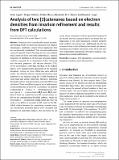Files in this item
Analysis of two [2]catenanes based on electron densities from invariom refinement and results from DFT calculations
Item metadata
| dc.contributor.author | Luger, Peter | |
| dc.contributor.author | Dittrich, Birger | |
| dc.contributor.author | Mebs, Stefan | |
| dc.contributor.author | Slawin, Alexandra M.Z. | |
| dc.contributor.author | Leigh, David A. | |
| dc.date.accessioned | 2019-09-23T23:38:49Z | |
| dc.date.available | 2019-09-23T23:38:49Z | |
| dc.date.issued | 2018-10-25 | |
| dc.identifier | 256188054 | |
| dc.identifier | 21710db6-6528-4aed-a003-6be45bad1158 | |
| dc.identifier | 85054391047 | |
| dc.identifier | 000446429600001 | |
| dc.identifier.citation | Luger , P , Dittrich , B , Mebs , S , Slawin , A M Z & Leigh , D A 2018 , ' Analysis of two [2]catenanes based on electron densities from invariom refinement and results from DFT calculations ' , Zeitschrift fur Naturforschung - Section B Journal of Chemical Sciences , vol. 73 , no. 10 , pp. 677-687 . https://doi.org/10.1515/znb-2018-0179 | en |
| dc.identifier.issn | 0932-0776 | |
| dc.identifier.other | ORCID: /0000-0002-9527-6418/work/56861653 | |
| dc.identifier.uri | https://hdl.handle.net/10023/18542 | |
| dc.description | The authors are grateful to the Deutsche Forschungsgemeinschaft (DFG) for financial support by project DI 921/6-1. | en |
| dc.description.abstract | Catenanes are of considerable interest as potential building blocks for molecular machines. The simplest [2]catenanes, Hopf links, consist of two macrocycles that are mechanically interlocked. This unusual architecture cannot be opened without breaking at least one covalent bond. Based on these structural characteristics, unusual properties on Hirshfeld or electrostatic potential surfaces could be expected. For a comparison of their structural and electronic properties, the electron densities (EDs) of two [2]catenanes, coded H22 and H4L7 in the original papers, were examined after application of the invariom formalism, relying on X-ray diffraction data collected earlier. The obtained electron density distributions were subjected to an analysis using the QTAIM formalism to yield bond and atomic properties. Moreover, molecular Hirshfeld surfaces and electrostatic potentials (ESP) were calculated. There are different types of intra- and intermolecular interactions in these two [2]catenanes. In addition to classical N-H···N and C-H···O hydrogen bonds, various types of π···π interactions in H22 and in H4L7 exist. Most of them are verified by local ED concentrations visible on the corresponding Hirshfeld surfaces, except for the parallel π···π interactions in H22, which are either too weak or too diffuse to generate an ED signal on the Hirshfeld surface between the contributing aromatic rings. The electrostatic potentials (ESPs) were calculated and displayed on molecular surfaces. The interaction in the cavity of one macrocycle with the penetrated fragment of the second one was examined and it was found that corresponding to the above-mentioned contacts attractive and repulsive interactions exist. Additionally the ED was examined using results of density functional calculations, including non-covalent interaction index (NCI) and electron localizability indicator (ELI-D) surface analysis, complementing experimental findings. | |
| dc.format.extent | 11 | |
| dc.format.extent | 1804136 | |
| dc.language.iso | eng | |
| dc.relation.ispartof | Zeitschrift fur Naturforschung - Section B Journal of Chemical Sciences | en |
| dc.subject | Catenanes | en |
| dc.subject | DFT calculations | en |
| dc.subject | Electron density | en |
| dc.subject | Invariom formalism | en |
| dc.subject | Molecular machines | en |
| dc.subject | QD Chemistry | en |
| dc.subject | Chemistry(all) | en |
| dc.subject | NDAS | en |
| dc.subject.lcc | QD | en |
| dc.title | Analysis of two [2]catenanes based on electron densities from invariom refinement and results from DFT calculations | en |
| dc.type | Journal article | en |
| dc.contributor.institution | University of St Andrews. School of Chemistry | en |
| dc.contributor.institution | University of St Andrews. EaSTCHEM | en |
| dc.identifier.doi | 10.1515/znb-2018-0179 | |
| dc.description.status | Peer reviewed | en |
| dc.date.embargoedUntil | 2019-09-24 |
This item appears in the following Collection(s)
Items in the St Andrews Research Repository are protected by copyright, with all rights reserved, unless otherwise indicated.

